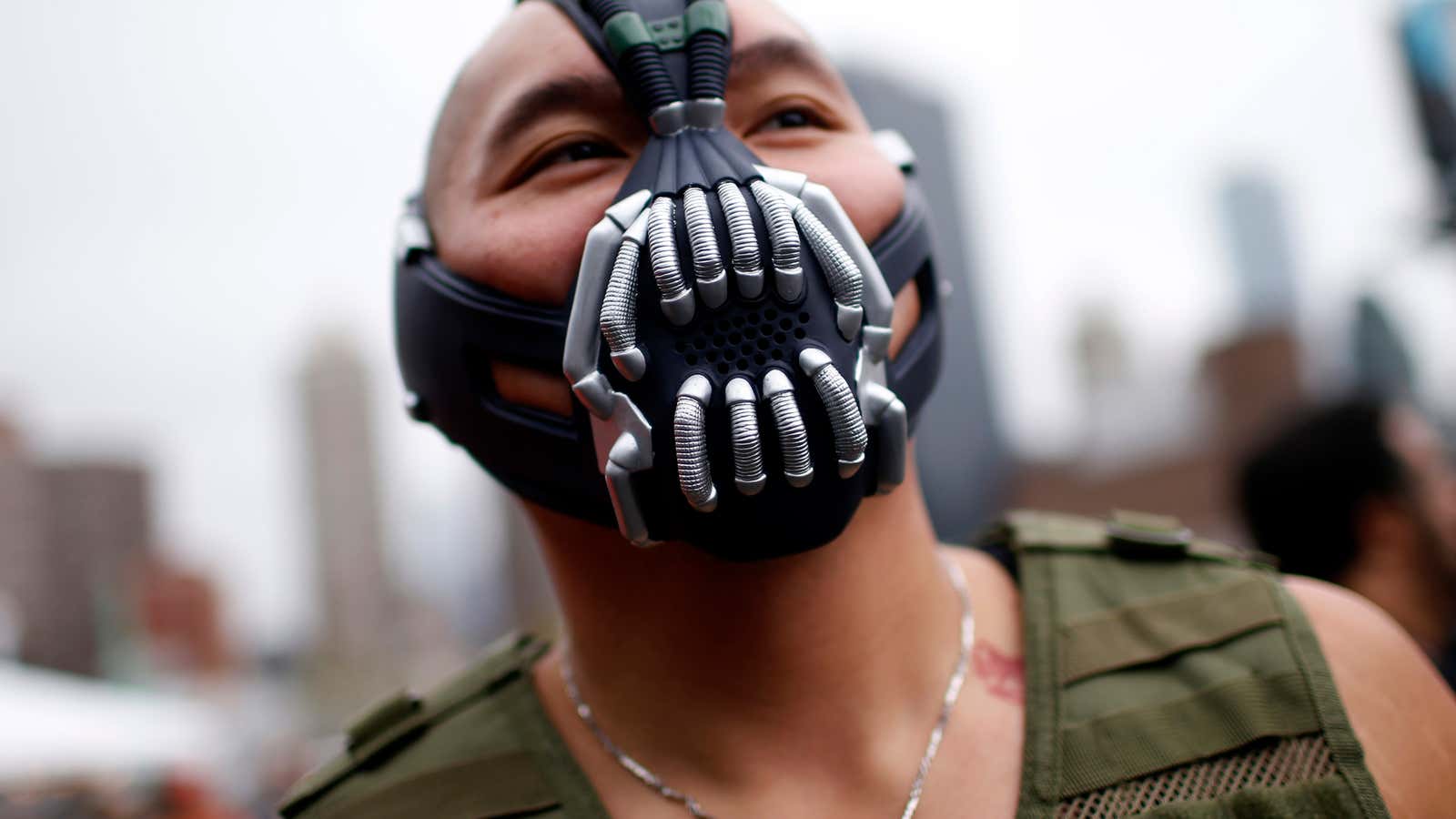In November 2015, a pair of white supremacists—one in an Under Armor balaclava, the other in a gray keffiyeh—filmed themselves driving toward a Black Lives Matter protest near downtown Minneapolis. Identifying themselves as “SaigaMarine” and “Black Powder Ranger,” the pair brandished a gun and pledged “reverse cultural enriching” while exhorting their viewers to “stay white!”
Before signing off, however, one of the men tossed a pop culture reference in between racial slurs. “The fire rises,” he said. That’s a line from Bane—the Batman villain most recently popularized by Tom Hardy in 2012’s The Dark Knight Rises. A bit later, having arrived at the protest, the pair offered more rationale for why they’d showed up at the demonstration. It certainly wasn’t to protest the police shooting of 24-year-old Jamar Clark: “We are here to see the fire rise.”
Now, just over a year later, the world has witnessed the ascendancy of a US president buoyed by white nationalists. Donald Trump himself slipped into the language of Bane, wittingly or not, during his inauguration speech. The language Trump lifted from Bane was, on its face, relatively anodyne, little more than a political platitude assuring his supporters that he was returning governance to them. As president, Trump said, he was “giving [power] back to you, the people.” But for those who have been following the threads of white nationalism for the better part of Trump’s campaign, the reference was impossible to miss.
Of course, Batman, like Bane, clearly carries his own fascistic—and criminal—tendencies. But the Caped Crusader risks his life protecting the existing order within Gotham: the pluralistic, liberal democracy that allowed his parents to prosper.
Bane, on the other hand, seeks a populist implosion and political decapitation, brought on by “necessary evil” and violence. He wants to overthrow the elite in the pursuit of economic chauvinism and revolutionary purity. (A cleansing, as it were, by fire.)
If anything, it’s the revolutionary aspects of Bane’s rhetoric—and maybe a bit of projecting about Bane’s physical prowess—that continues to attract alt-right fans. (Such revolutionary fervor also helps bridge the gap between the alt-right and Trump’s chief strategist Stephen Bannon, a self-labeled “Leninist” who “wants to destroy all of today’s establishment.”) White nationalists dream of obliterating a society ruled by overly restrictive, liberal guidelines and political correctness, replacing it with one in which they can make or break rules as they see fit. Bane is their Leviathan: An inspirational figure representing a brand of populism that would replace identity politics with a retrograde, individualist patriarchy.
Indeed, the armed counter-protesters in Minnesota were far from the only white nationalists to look to Bane as a polestar over the past two years. From online postings at the most popular white supremacist destinations, to in-person gatherings among the alt-right, Bane—a barrel-chested villain who is best-known in the comic book series for breaking the Bat’s back—remains an oft-cited character within the white nationalist community.
For instance, in September, the Twitter account for Virginia Dare, one of the flagship sites within the alt-right, wrote, “Listening to Bane quotes from The Dark Knight Rises for motivational purposes while you write. #JustAltRightThings.” A few weeks later, the account said that the “constitution of the #AltRight regime will simply be a transcript of Bane quotes. At least one must be cited to justify any action.”
In mid-2016, another white nationalist website attempted to delineate why Bane—a “Radical Traditionalist,” according to Virginia Dare—had found such traction within the white nationalist community. As the post’s authors write, Bane is “motivated to restore the natural balance to the world by putting an end to a decadent society which will inevitably fall. In a sentence: that which is falling must also be pushed.” In The Dark Knight Rises, which sees Bane isolate Gotham from both Batman and the broader world alike, “Bane is Gotham’s reckoning, not Gotham’s executioner. Only the people of Gotham can be the architects of their own destruction.”
The alt-right’s infatuation with Bane is not without irony. Not only does Bane eventually fail in his pursuit of a Hobbesian Gotham, he is also “perhaps the greatest Latino comic book character” yet created, as Temple University’s Ariel Arnau has written. (It seems unlikely that most of Bane’s alt-right fans are aware he’s an undocumented Hispanic migrant—a fact left out of the Christopher Nolan’s script.) Likewise, in The Dark Knight Rises, Bane is eventually revealed to be little more than a front for other, more nefarious actors. Ultimately, his economic populism is a ruse, a rhetorical device used to stoke the most gullible of Gotham—citizens and criminals alike, who claw over one another as their society degrades, chaos settling in around them.
From a liberal perspective, Bane’s failures seem more Trumpian than his successes. While both Bane and Trump campaigned on a platform of economic populism, Trump’s rise will almost certainly result in greater fiscal inequalities, not to mention ethical scandals nonpareil and a raft of difficult-to-meet expectations. Much like Bane failed to squelch Gotham’s (and Batman’s) spirit in The Dark Knight Rises, so too will Trump find it exceedingly difficult to balance the desires of his alt-right supporters against the priorities of more mainstream GOP operatives.
In the process, and much like Bane before him, Trump’s stewardship may end up causing plenty of undue pain to his supporters and detractors alike. White nationalists may look to Bane, and perhaps, see a fire rising. But America isn’t Gotham, and the country’s well-being is still up to us, the people.
